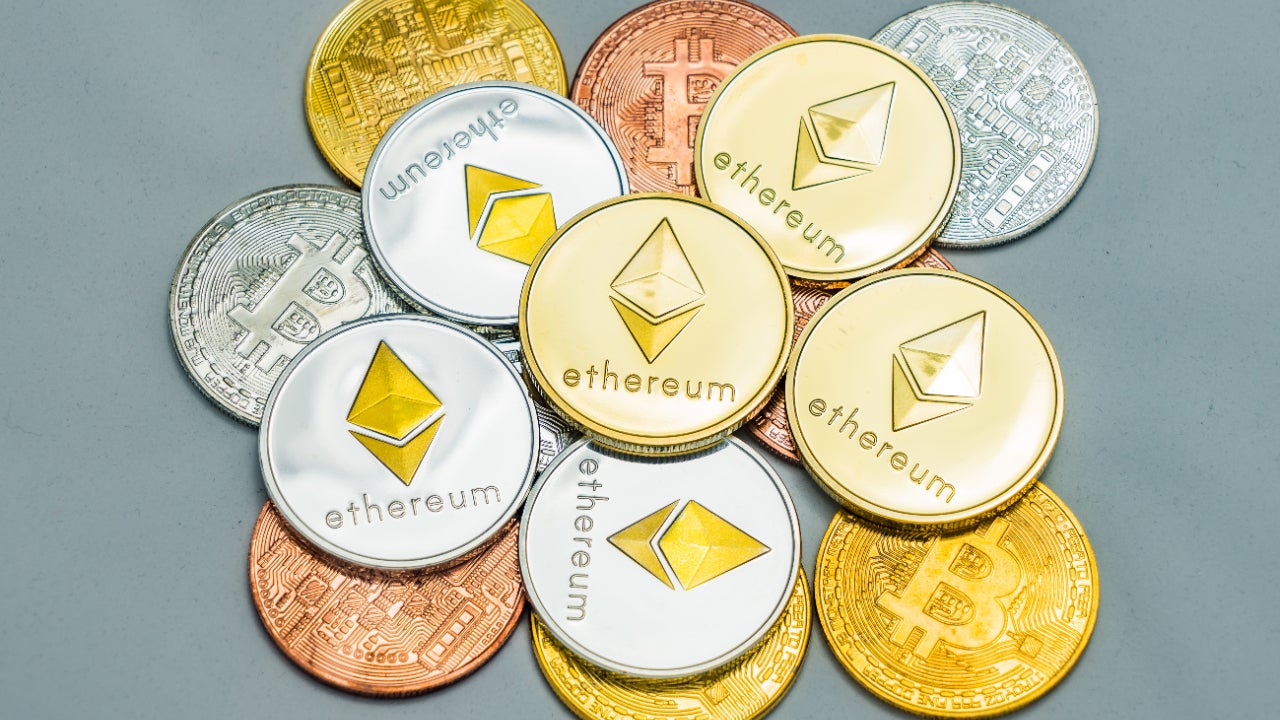Introduction
Welcome to the digital age where new technologies are constantly reshaping the way we interact, transact, and conduct business. One such disruptive technology that has gained significant attention is digital currency. While cryptocurrencies like Bitcoin have garnered widespread fame, the concept of creating your own digital currency may seem intimidating to many.
However, in this article, we will demystify the process and provide you with a comprehensive guide on how to create your very own digital currency. Whether you are a tech enthusiast exploring blockchain technology or an entrepreneur looking to revolutionize the financial sector, this guide will equip you with the knowledge and understanding needed to embark on your digital currency journey.
Creating a digital currency comes with numerous advantages. It allows you to customize and control every aspect of your currency, from its core mechanics to its security measures. By launching your own digital currency, you open up new possibilities for financial innovation and empower your users with a secure and efficient means of transaction.
However, before diving into the technicalities of creating a digital currency, it is important to have a fundamental understanding of what digital currencies are and the underlying technology that powers them.
In the following sections, we will explore the concept of digital currencies, delve into the intricacies of blockchain technology, and discuss important factors you need to consider before embarking on your digital currency creation journey. So, let us embark on this exciting exploration of creating your very own digital currency!
Understanding Digital Currencies
Digital currencies, also known as cryptocurrencies, are virtual or digital representations of value that can be used as a medium of exchange. Unlike traditional currencies issued and regulated by governments, digital currencies operate on decentralized networks known as blockchains. These blockchains, which are powered by advanced cryptographic algorithms, provide a secure and transparent framework for recording and verifying transactions.
One of the key features of digital currencies is their decentralization. Instead of relying on a central authority like a bank or government, digital currencies are governed by a network of participants who collectively validate and maintain the integrity of the blockchain. This decentralized nature ensures that transactions are secure, transparent, and resistant to censorship.
Another defining characteristic of digital currencies is their digital scarcity. Most digital currencies have a finite supply, ensuring that they cannot be arbitrarily created or inflated. This scarcity, coupled with the growing popularity of digital currencies, has contributed to their increasing value and investment potential.
Transactions involving digital currencies are typically conducted using digital wallets, which serve as the virtual equivalent of a physical wallet. These wallets allow users to store, send, and receive digital currencies securely. In addition, wallets often provide features such as transaction history, balance monitoring, and the ability to convert between different digital currencies.
While Bitcoin remains the most well-known and widely adopted digital currency, there are thousands of other digital currencies in existence, each with its own unique features and use cases. Some digital currencies aim to address specific industry needs or provide specialized functionalities, such as privacy or scalability.
Overall, digital currencies offer numerous advantages over traditional fiat currencies. They enable faster and more secure transactions, lower fees, and greater financial inclusivity. Additionally, the underlying blockchain technology provides a robust infrastructure for implementing innovative applications beyond simple currency transactions, including smart contracts and decentralized applications.
In the next section, we will explore the technology that underpins digital currencies and plays a crucial role in their creation: blockchain technology.
What is Blockchain Technology?
Blockchain technology is the foundational technology behind digital currencies, serving as a decentralized and transparent ledger that records and verifies transactions. It can be thought of as a digital ledger that is maintained by a network of computers or nodes, distributed across multiple locations.
At its core, a blockchain is composed of a chain of blocks, with each block containing a list of transactions. These transactions are encrypted, timestamped, and linked to the previous block in the chain, forming a tamper-proof record of all the transactions that have ever occurred on the network.
One of the key characteristics of blockchain technology is its decentralization. Instead of relying on a central authority, such as a bank or government, to verify and validate transactions, blockchains rely on a consensus mechanism. This ensures that all participants in the network agree on the state of the blockchain and the validity of transactions.
Blockchains can be public, meaning that anyone can participate and view the transactions on the network, or private, where access and participation are restricted to a specific group of participants. Public blockchains, like the Bitcoin blockchain, provide transparency and immutability, making it impossible to alter or manipulate past transactions without consensus from the entire network.
Another important aspect of blockchain technology is its security. The decentralized nature of blockchains, coupled with cryptographic algorithms, ensures that the data stored on the blockchain is secure and resistant to tampering or hacking attempts. Additionally, since each block is linked to the previous block, modifying an individual block would require modifying all subsequent blocks, making it computationally infeasible to alter the blockchain’s history.
Blockchain technology has applications beyond digital currencies. It can be used to create decentralized applications (DApps), implement smart contracts, and facilitate secure and transparent record-keeping in various industries like supply chain management, healthcare, and finance.
As you venture into creating your own digital currency, it is crucial to understand the intricacies of blockchain technology and how it can be leveraged to build a robust and secure system for your currency. The next section will discuss important factors to consider before embarking on the creation process.
Factors to Consider before Creating a Digital Currency
Creating a digital currency involves careful planning and consideration of various factors. Before diving into the technical aspects of development, it’s important to evaluate the following key factors:
- Use Case: Define the purpose and use case of your digital currency. Determine whether it will be used for peer-to-peer transactions, loyalty rewards, fundraising, or any other specific application.
- Market Demand: Assess the market demand for your digital currency. Research existing digital currencies in the market and identify gaps or potential areas for improvement. Understand the target audience and their specific needs.
- Legal and Regulatory Compliance: Comply with the legal and regulatory requirements of the jurisdictions in which you plan to operate. Understand the legal implications of launching a digital currency and ensure you have the necessary licenses and permissions.
- Scalability and Performance: Consider the scalability and performance requirements of your digital currency. Assess the capacity of the underlying blockchain platform to handle the expected transaction volume and evaluate its speed, efficiency, and ability to scale as your user base grows.
- Security: Implement robust security measures to protect your digital currency from cyber attacks and ensure the safety of user funds. Consider features such as encryption, multi-factor authentication, and periodic security audits.
- User Experience: Focus on creating a user-friendly experience for your digital currency. Design intuitive and easy-to-use interfaces for wallets, transaction processes, and account management. Consider the needs and preferences of your target audience to provide a seamless user experience.
- Partnerships and Integration: Explore partnerships with businesses or organizations that can help enhance the adoption and utility of your digital currency. Look for opportunities to integrate your currency with existing platforms or systems to broaden its reach and functionality.
By carefully evaluating these factors, you can lay a solid foundation for the success of your digital currency. This initial planning stage will help guide the development and implementation process and increase the likelihood of creating a currency that meets user needs and expectations.
Step 1: Define your Objectives and Use Cases
Before diving into the technical aspects of creating a digital currency, it is vital to clearly define the objectives and use cases for your currency. This step will help you establish a clear vision and guide the development process.
Consider the following factors when defining your objectives:
- Purpose: Determine the main purpose of your digital currency. Will it be used as a means of payment, a store of value, or for a specific application such as fundraising or loyalty rewards?
- Target Audience: Identify the target audience for your currency. Understand their needs, preferences, and pain points. This will help you tailor the features and functionality of your currency to meet their requirements.
- Market Differentiation: Analyze existing digital currencies in the market and identify gaps or areas for improvement. Pinpoint what sets your currency apart from the competition and how it can provide unique value to users.
- Economic Model: Define the economic model for your currency. Will it have a fixed supply or will new coins be minted over time? Consider factors such as inflation, deflation, and monetary policies to ensure a sustainable and balanced economic system.
In addition to defining your objectives, it is crucial to identify the specific use cases for your digital currency. This will help you determine the features and functionalities you need to implement. Consider the following questions:
- Transaction Speed and Scalability: Will your currency be optimized for fast and efficient transactions? Assess the expected transaction volume and evaluate the scalability of the underlying blockchain platform to ensure it can handle the load.
- Privacy and Anonymity: Will your currency prioritize user privacy and anonymity? Determine whether you need to implement privacy-enhancing features, such as zero-knowledge proofs or ring signatures, to protect user identities and transaction details.
- Smart Contracts and Programmability: Will your currency support smart contracts and programmable functionality? Consider whether you want to enable developers to build applications on top of your currency or establish specific rules and conditions for transactions.
- Interoperability: Identify if your currency needs to integrate or interoperate with existing blockchain networks or traditional financial systems. This will influence the choice of blockchain platform and the design of protocols for interoperability.
By defining your objectives and use cases, you will have a clear roadmap for creating your digital currency. This step lays the foundation for the technical decisions that follow and ensures that your currency aligns with your vision and meets the needs of your target audience.
Step 2: Select an Appropriate Blockchain Platform
Once you have defined the objectives and use cases for your digital currency, the next step is to select an appropriate blockchain platform to build your currency upon. There are several factors to consider when choosing a blockchain platform:
- Scalability: Evaluate the scalability of the blockchain platform. Consider the transaction throughput and the ability to handle a growing number of users and transactions. Choose a platform that can accommodate your expected growth.
- Security: Assess the security features of the blockchain platform. Look for platforms with a strong track record of security and resistance against attacks. Consider features such as cryptographic algorithms, consensus mechanisms, and data encryption.
- Flexibility: Consider the flexibility and programmability of the blockchain platform. Determine if it supports smart contracts and provides a robust framework for implementing the desired features and functionalities of your digital currency.
- Community and Support: Evaluate the size and activity level of the developer community behind the blockchain platform. A vibrant community can provide support, resources, and guidance throughout the development process and help address any challenges that may arise.
- Interoperability: If interoperability with other blockchain networks or traditional systems is important for your digital currency, choose a platform that supports interoperability protocols or has integration capabilities.
- Cost: Consider the cost implications of utilizing the blockchain platform. Assess the fees associated with transactions, deployment, and maintenance. Ensure that the cost aligns with your budget and long-term sustainability plan.
- Regulatory Compliance: Ensure that the chosen blockchain platform aligns with the legal and regulatory requirements of the jurisdictions you intend to operate in. Consider factors such as data privacy, identity verification, and compliance with financial regulations.
There are several popular blockchain platforms to choose from, including Ethereum, Hyperledger, Stellar, and EOS, each with its own strengths and weaknesses. Evaluate each platform based on the factors mentioned above to make an informed decision.
It is important to note that migrating your digital currency to a different blockchain platform can be complex and time-consuming. Therefore, thoroughly research and consider your options before making a decision, as it will have a significant impact on the scalability, security, and functionality of your digital currency.
In the next step, we will discuss how to design the core mechanics of your digital currency.
Step 3: Design the Core Mechanics of your Currency
Designing the core mechanics of your digital currency involves determining the fundamental features and functionalities that will govern its operation. This step is crucial as it defines how your currency will be created, distributed, and utilized. Consider the following elements when designing the core mechanics of your currency:
- Tokenomics: Define the supply and distribution of your currency. Determine whether your currency will have a fixed supply or if new coins will be minted over time. Consider factors such as inflation, deflation, and the mechanisms for distributing coins to users.
- Consensus Mechanism: Select a consensus mechanism that aligns with your goals and ensures the security and integrity of the blockchain. Popular consensus mechanisms include Proof of Work (PoW), Proof of Stake (PoS), and Delegated Proof of Stake (DPoS).
- Transaction Validation: Set rules for validating transactions on the blockchain. Determine the requirements for a transaction to be considered valid and how transaction fees will be calculated.
- Rewards and Incentives: Define the incentives for users to participate and contribute to the network. Consider reward mechanisms such as staking, masternodes, or transaction fees shared with network participants.
- Governance: Establish a system for making decisions and implementing changes to the currency. Determine how consensus will be reached on proposed changes and how stakeholders can participate in the governance process.
- Asset Management: Consider features such as token burning, token freezing, or multi-signature capabilities to manage the supply and control the movement of assets within the ecosystem.
- Compatibility: If interoperability with other blockchain networks or existing systems is important, design your currency to be compatible with relevant standards and protocols. This will facilitate integrations and interactions with other platforms.
Align the core mechanics of your currency with the objectives and use cases defined earlier. Ensure that the design choices not only promote the functionality and security of your currency but also cater to the needs of your target audience.
It is worth noting that designing the core mechanics may involve complex technical considerations. Consulting with blockchain developers, experts, or experienced professionals can help ensure that the design is effective, efficient, and aligned with industry best practices.
In the next step, we will explore how to choose the right consensus mechanism for your digital currency.
Step 4: Choose the Right Consensus Mechanism
Choosing the right consensus mechanism is a critical step in the creation of your digital currency. Consensus mechanisms ensure that all participants in the network agree on the validity of transactions and maintain the integrity of the blockchain. Consider the following factors when selecting a consensus mechanism:
- Security: Evaluate the security features of different consensus mechanisms. Look for mechanisms that provide robust protection against attacks and ensure the immutability of the blockchain.
- Scalability: Consider the scalability capabilities of each consensus mechanism. Assess how it handles increasing transaction volumes and supports a growing user base without sacrificing performance.
- Energy Efficiency: Assess the energy efficiency of the consensus mechanism. Some mechanisms, such as Proof of Work (PoW), require significant computational power, leading to high energy consumption. Consider alternatives like Proof of Stake (PoS) or Delegated Proof of Stake (DPoS), which consume less energy.
- Decentralization: Evaluate the level of decentralization provided by each consensus mechanism. Consider whether you want a consensus mechanism that requires a large number of participants to validate transactions or allows for a smaller group of validators.
- Fork Prevention: Consider whether the consensus mechanism provides built-in mechanisms to prevent forks or resolve them effectively if they occur. Forks can impact the stability and trustworthiness of the blockchain.
- Consensus Finality: Evaluate the finality of transactions provided by the consensus mechanism. Some mechanisms offer immediate finality, while others rely on confirmation through subsequent blocks. Consider the importance of transaction finality in your digital currency’s use case.
- Developer Community: Assess the community support and development activity around different consensus mechanisms. A vibrant community can provide ongoing updates, improvements, and support for the consensus mechanism.
Popular consensus mechanisms include Proof of Work (PoW), Proof of Stake (PoS), Delegated Proof of Stake (DPoS), and Practical Byzantine Fault Tolerance (PBFT). Each mechanism has its own characteristics and is suitable for different use cases and goals.
It is important to thoroughly research and understand the advantages and disadvantages of each consensus mechanism before making a decision. Consider consulting with blockchain experts or developers to gain insights and guidance on the selection process.
Choosing the right consensus mechanism is crucial for the security, scalability, and efficiency of your digital currency. Making an informed decision in this step will significantly impact the performance and success of your currency.
In the next step, we will discuss the crucial aspect of establishing security measures for your digital currency.
Step 5: Establish Security Measures
Establishing robust security measures is a critical step in creating a secure and trustworthy digital currency. By implementing the right security measures, you can protect your currency from potential threats and ensure the safety of user funds. Consider the following security measures:
- Encryption: Utilize strong encryption algorithms to encrypt data and protect sensitive information. This includes encrypting user wallets, transaction data, and any other data stored on the blockchain.
- Secure Key Management: Implement secure key management practices to safeguard private keys associated with user wallets. Use hardware wallets or cold storage solutions to store private keys offline and protect them from unauthorized access.
- Multi-Factor Authentication: Enable multi-factor authentication for wallets and user accounts. This adds an additional layer of security by requiring users to provide multiple forms of verification, such as a password and a unique code sent to their mobile device.
- Regular Security Audits: Conduct regular security audits to identify any vulnerabilities or weak points in your digital currency system. Engage with external security experts to perform penetration testing and ensure all security aspects are thoroughly evaluated.
- Secure Development Practices: Follow secure development practices while creating your digital currency. This includes adhering to coding standards, performing code reviews, and implementing secure coding practices to minimize the chances of vulnerabilities being introduced.
- Continual Monitoring: Implement real-time monitoring for any suspicious activities or anomalous behavior within the network. Use intrusion detection systems and implement mechanisms to quickly detect and respond to potential security breaches.
- Regular Updates: Stay up-to-date with software and security patches for your digital currency software and blockchain platform. Regularly update and upgrade components to address any known security vulnerabilities.
- Community Reporting: Establish a system for community reporting of security vulnerabilities. Encourage users and developers to report any potential security issues responsibly and provide a clear process for addressing and resolving reported vulnerabilities.
Security should be an ongoing process, and it is crucial to remain vigilant and proactive in maintaining the integrity and safety of your digital currency. Keep abreast of the latest security practices, industry standards, and emerging threats to continuously enhance the security of your currency.
Remember, the security of your digital currency is paramount to build trust among users and ensure the long-term sustainability of your currency.
In the next step, we will discuss the development of smart contracts for your digital currency.
Step 6: Develop Smart Contracts
Smart contracts play a crucial role in the functionality and automation of your digital currency. They are self-executing contracts with the terms and conditions encoded directly into the blockchain. Smart contracts enable the execution of transparent, secure, and tamper-proof transactions between users.
When developing smart contracts for your digital currency, consider the following steps:
- Identify Use Cases: Determine the specific use cases for which you want to utilize smart contracts. This can include handling transactions, enforcing rules, or implementing specific functionalities within your currency ecosystem.
- Design Contract Architecture: Architect the structure and logic of your smart contracts. Plan how the contracts will interact with each other and the overall flow of data and processes within the system.
- Define Contract Functions: Clearly define the functions and operations that will be carried out by the smart contracts. Specify how these functions interact with the blockchain and handle different types of transactions.
- Implement Secure Coding Practices: Adhere to secure coding practices while writing the smart contract code. Follow industry best practices, conduct code reviews, and ensure the code is free from vulnerabilities that could be exploited by attackers.
- Test and Debug: Thoroughly test and debug your smart contracts to identify and address any issues or bugs. Conduct extensive testing to ensure the contracts behave as expected and handle various scenarios correctly.
- Audit Smart Contracts: Consider engaging external auditors who specialize in smart contract security to perform a comprehensive security audit. This will help identify vulnerabilities and suggest improvements to strengthen the security of your contracts.
- Deploying Contracts: Once the smart contracts have undergone rigorous testing and auditing, deploy them on the selected blockchain platform. Take the necessary precautions and ensure a smooth deployment process.
It is crucial to have a solid understanding of the programming languages and frameworks used for smart contract development. Ethereum’s Solidity language is widely used for writing smart contracts, but other blockchains may use different languages, such as Vyper or Chaincode for Hyperledger Fabric.
Keep in mind that once deployed, smart contracts are immutable. Therefore, it is crucial to thoroughly plan, develop, and test them to ensure their correctness and efficiency. Smart contracts are at the heart of your digital currency, so their development and security should be treated with utmost care and attention.
In the next step, we will discuss the creation of wallets and user interfaces for your digital currency.
Step 7: Create the Wallet and User Interfaces
Creating user-friendly and intuitive wallets and user interfaces is a crucial step in ensuring a seamless and enjoyable experience for users of your digital currency. Wallets are the primary tool through which users interact with your currency, manage their funds, and initiate transactions. Consider the following steps when creating wallets and user interfaces:
- Design: Develop a user interface that is visually appealing, easy to navigate, and intuitive to use. Consider the needs and preferences of your target audience to create a design that resonates with them.
- Wallet Functionality: Determine the essential features and functionalities for your wallet. These can include creating new wallets, importing existing wallets, checking balances, sending and receiving funds, transaction history, and security features.
- Multi-Platform Accessibility: Ensure that the wallet and user interfaces are accessible across different platforms and devices. Support web-based wallets and native mobile applications to cater to a wide range of users.
- Security: Implement strong security measures to protect user funds and sensitive data. Utilize encryption, two-factor authentication, and secure key management practices to ensure the safety of wallets and avoid unauthorized access.
- Usability Testing: Conduct usability testing to gather feedback from users and refine the user interface design. Identify any areas of confusion or potential improvements to enhance the overall user experience.
- Integration: Ensure proper integration between the wallet and the underlying blockchain. Test transaction functionality and ensure seamless interaction with the blockchain platform.
- Customer Support: Provide user support channels, such as FAQs, tutorials, and a dedicated customer support team. Users should have access to assistance and guidance whenever they encounter issues or have questions regarding the wallet and the digital currency.
Remember to optimize user interfaces for performance and efficiency, ensuring smooth navigation and responsiveness. Regular updates and enhancements based on user feedback will help refine the wallet and improve user satisfaction.
Creating a user-friendly wallet and user interfaces is essential for encouraging adoption and engagement with your digital currency. A well-designed and user-centric interface will increase user trust and make your currency more accessible to a wider audience.
In the next step, we will discuss testing and deploying your digital currency.
Step 8: Test and Deploy your Digital Currency
After creating your digital currency, the final step is to thoroughly test and deploy it to the intended network. Testing helps identify and resolve any issues or bugs before making your currency available to users. Consider the following steps when testing and deploying your digital currency:
- Testnet Deployment: Deploy your digital currency on a testnet first before releasing it on the mainnet. This allows you to simulate real-world conditions and test the functionality, security, and performance of your currency in a controlled environment.
- Functional Testing: Test the core functionalities and operations of your currency, such as creating wallets, sending and receiving transactions, and verifying balances. Ensure all features work as intended and handle various scenarios correctly.
- Security Testing: Perform thorough security testing to identify any vulnerabilities or weaknesses in your currency’s system. Conduct penetration testing and vulnerability assessments to address and remediate any potential security risks.
- Load Testing: Assess the scalability and performance of your currency by conducting load testing. Simulate high transaction volumes and concurrent user activity to evaluate how your currency handles the increased workload.
- User Acceptance Testing: Involve a group of external users to perform user acceptance testing. Gather feedback, evaluate the user experience, and address any usability issues or concerns raised by the testers.
- Documentation and Support: Create comprehensive documentation and user guides for your digital currency. Provide clear instructions on how to use the currency, access wallets, and perform transactions. Ensure you have a well-defined support system in place to address user queries and issues.
- Mainnet Deployment: Once you are satisfied with the results of testing, deploy your digital currency on the mainnet. Follow the deployment process provided by the blockchain platform and ensure the necessary configurations and settings are accurately implemented.
- User Education and Adoption: Educate users about your digital currency and its features. Provide resources, tutorials, and guides to help users understand how to utilize your currency efficiently and address any concerns or questions they may have.
It is essential to maintain ongoing monitoring and support after deploying your digital currency. Continually monitor the performance and security of your currency, provide regular updates and bug fixes, and address any issues reported by users.
By diligently testing and deploying your digital currency, you can ensure a smooth user experience, identify and fix any potential issues, and lay a strong foundation for the success of your currency in the market.
Congratulations! You have now completed the process of creating, testing, and deploying your digital currency. Your currency is ready to be utilized and make an impact in the digital financial landscape.
Conclusion
Congratulations on completing the journey of creating your own digital currency! Throughout this guide, we have explored the various steps involved in bringing your digital currency idea to life. From defining your objectives and use cases to selecting the right blockchain platform, designing core mechanics, establishing security measures, developing smart contracts, creating user interfaces, and finally, testing and deploying your currency, each step has been crucial in ensuring a successful outcome.
The process of creating a digital currency requires careful planning, technical knowledge, and a deep understanding of the needs and preferences of your target audience. By following the steps outlined in this guide, you have laid a strong foundation for creating a secure, scalable, and user-friendly digital currency.
It is important to note that the world of digital currencies is continually evolving, and staying up-to-date with the latest trends, technologies, and regulatory developments is crucial for the long-term success of your currency. Additionally, fostering community engagement, partnering with relevant stakeholders, and continuously improving your currency’s features and functionalities will contribute to its growth and adoption.
Remember to prioritize security at every stage of your digital currency’s lifecycle. Regularly update and test your currency’s security measures to protect user funds and maintain trust within the community.
Lastly, keep an open mind and remain adaptable as you navigate the dynamic landscape of digital currencies. Embrace innovation and seek opportunities to enhance your currency’s value and utility.
By following this guide and incorporating your own unique vision and creativity, you have taken an exciting step towards revolutionizing the financial landscape with your very own digital currency. Best of luck on your journey, and may your currency thrive and make a positive impact in the digital world!

























